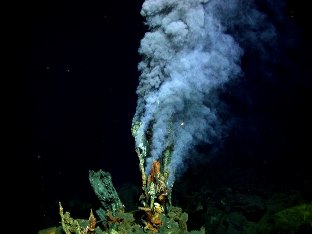Earth & The Environment
Can We Literally Bury Climate Change Components?
APR 15, 2014 12:00 AM PDT
Share
Could the Environment of Deep-Sea Vents Create Life?
 A great way to start a debate, if not an outright fight, is to discuss theories of how life started on Earth.
A great way to start a debate, if not an outright fight, is to discuss theories of how life started on Earth. One of the more intriguing theories evolved (pun intended) from the 1977 discovery of unusual biological systems that resided in the harsh environment of hydrothermal vents on the deep-sea floor. These systems have no exposure to sunlight and live in a mixture of carbon dioxide, sulfide, and hydrogen from the emission of the nearby geysers.
While this mixture is inhospitable to most life on today's Earth, it does have similarities to the environment of the early Earth, and it provides the basic building blocks and reaction conditions to potentially produce microbial life forms-thus leading to speculation that life on Earth may have chemically originated in conditions similar to today's deep-sea vents.
Methanethiol, the simplest possible carbon-sulfur compound, is considered to be an ancient precursor of one of the more prevalent enzymes in living organisms today, Acetyl-CoA. Since high levels of starting materials are known to exist near the vents, the thinking was that methanethiol could act as the bridging material between a lifeless mix of chemicals and the Earth's first life forms.
If methanethiol could be found in significant levels near the vents, produced from purely chemical processes, it would lend more credence to this theory of life.
A research group from the Woods Hole Oceanic Institute set out to answer this question by measuring methanethiol concentrations near deep-sea vents, in multiple locations around the world, over the course of four years. Their study was published in the recent Proceedings of the National Academy of Science.
The team checked 38 different hydrothermal fluid emissions from vents, some in areas with an overabundance of hydrogen (expected to allow for large production of methanethiol), and other areas where the chemical mixture was thought to be less conducive to methanethiol formation.
Collecting and preserving samples for analysis in this environment was a daunting task. However, one of the Woods Hole geochemists developed a vessel specifically for this purpose, known as an isobaric gas-tight sampler. The vessel preserved the hydrothermal fluid at the typical deep-sea pressure for subsequent dissolved gas analysis.
The team was surprised to find the opposite of what it expected-hydrogen-rich environments contained a relatively low amount of methanethiol, and hydrogen-deficient environments produced higher amounts of methanethiol.
In addition, the team found significant methanethiol in mixing areas where colder water mixes with the hot vent fluids below the seafloor. Ammonia was found as well, along with a few other markers-suggesting that the methanethiol is not being formed spontaneously, but instead is a breakdown product of living matter that is being killed off by the hot mixture.
While this finding puts a dent in the hydrothermal vent theory, it doesn't kill it entirely. There may be a different material other than methanethiol that can form under those conditions and serve as the bridge to life.
However, this finding does have one useful side possibility-finding the presence of methanethiol in samples from distant planets could be a significant indicator that life once existed there.
You May Also Like
Loading Comments...








